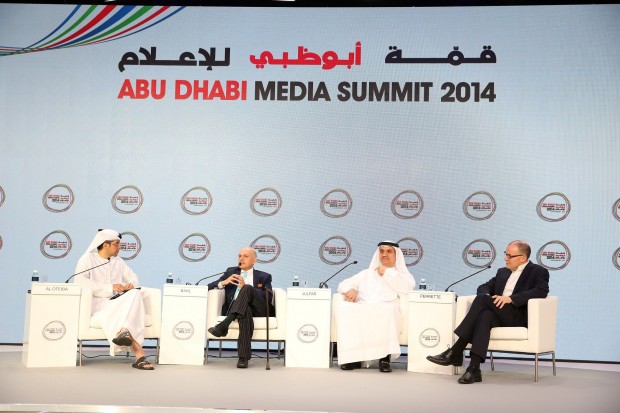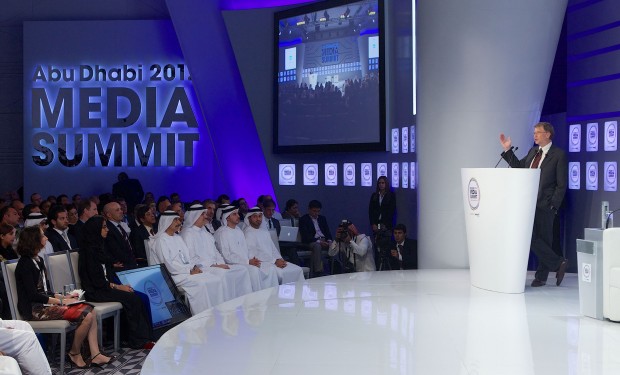The future of printed media in UAE

Participants discuss at the three-day Abu Dhabi media summit in Abu Dhabi, United Arab Emirates. Queen Rania Abdullah of Jordan delivered a keynote speech here on Tuesday and said that the Arab world shall not allow IS terrorists to hijack the region’s identity, but to encounter extremism through creating education, jobs and to retain the region’s lead in global cyberspace growth. (Xinhua/An Jiang)
Media in the Middle East has witnessed an extraordinary change over the past five years. The Middle East has become increasingly involved in world events and trade. Not only has it outdone its own accomplishments but has also placed itself on the global map of commercial success.
Arab media is a collective outcome of efforts by the Arab community to push back society’s strains and establish its presence on the world media map. To this day, there have been several challenges the media in the Middle East has faced. The news industry has had a rough decade, print readership is steadily declining, newspapers are closing, and journalists with decades of experience are being laid off work.
Some facts about Media in UAE:
According to the report of ‘The Arab Media Forum 2014’, newspapers in their current form will become insignificant by 2028. The extinction of traditional newspapers in the UAE is due to different factors that include consumption growth, fragmentation of the market, participation of the users, and personalization of content, evolving revenue models, generational change and increasing bandwidth.
The key factors that speed up newspaper extinction are increasing cost, performance of mobile phones, tablets, e-readers, changes in newsprint and print production costs, trends in advertising spend and uptake of digital news monetization mechanisms.
The social media report of 2015 explains that the use of new media is on par with global trends with high internet penetration levels in the Arab region. The UAE has the highest mobile internet usage. On average, people spend 4.33 hours using mobile phones every day; 1.28 of those hours are spent on the internet, and only 63 minutes on physical print.
What that means
We are in the middle of an industrial revolution in the media. At the center of this revolution is the rise of social media and the emerging Tablet PC, which brought with them new consumer demands and new ways of newsgathering and news distribution. Naturally, newsrooms are morphing and journalists are transitioning in response to the social, cultural and technological changes happening.
However, the changes happening in the news industry that are brought on by the rapid advances in technology should not be seen as a threat to traditional mass media, but as complementary – in reaching targeted audiences in a world of personalized media by offering digital narratives and customizable news experiences that allow users to share and participate.
Media companies are changing with time. Journalists in the UAE realize there is a need for journalists and journalism to transform and evolve along with the changes happening in the technological and cultural scenes. Most of the respondents say they are not worried about making the transition and many are already preparing themselves for the digital shift by learning multimedia skills.

Bill Gates, the co-founder of Microsoft Corp. and co-chair of the Bill & Melinda Gates Foundation, delivers a speech during the opening session of the three-day Abu Dhabi Media Summit, the United Arab Emirates. (Xinhua)
Who are the journalists of the UAE’s future?
Journalism for its part is not dead but merely evolving and the journalists of the future need to reinvent themselves. Dr. Khaled El Khaja, the Dean of Information and Media College in Ajman University for science and technology (AUST) emphasizes the need for journalists to adapt. “Too often, it seems, those of us who have been about building a community through journalism react with a “how dare they?” attitude toward those who construct communities through social media”.
“We have to get over that. People are more powerful now as consumers and shapers of news. The less keenly journalists applaud this development, the further behind we will be left until we fade to irrelevance.” Like it or not, the journalists of the future have to be more technology-savvy as news organizations become more digital-centric. Many journalism colleges in the UAE are already preparing their students for this certainty.
What does this mean for journalists?
As a result, journalists need to master new skills in the following:
- Multimedia (photos, graphics, video)
- Adobe Flash (graphics software)
- Video editing (Adobe premiere, Apple Pro)
- Digital Narratives (Constructing stories with info-graphics)
- Journalists will have to learn to work with an infographics team or a news visual design team to reinvent how to tell stories in digital platform.










































